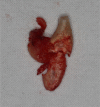Multiple idiopathic cervical root resorptions: report of one case with 8 teeth involved successively
- PMID: 24955199
- PMCID: PMC4057878
Multiple idiopathic cervical root resorptions: report of one case with 8 teeth involved successively
Abstract
Multiple idiopathic cervical root resorptions is a rare condition which is usually detected as an incidental radiographic finding. It involves more than 3 teeth in the same patient and the etiology remains elusive. Diagnosis and treatment of the defect is still challenging. The present report describes a case with progressive multiple external cervical resorption involving 8 teeth, including the history, clinical and radiographic findings. Treatment included surgical intervention and restoration of the defect. A 3-month reevaluation of the case confirmed a stable, uneventful clinical recovery.
Keywords: External root resorption; cervical lesion; tooth defect.
Figures





References
-
- Mueller E, Rony HR. Laboratory studies of an unusual case of resorption. J Am Dent Assoc. 1930;17:326–334.
-
- Yu VS, Messer HH, Tan KB. Multiple idiopathic cervical resorption: case report and discussion of management options. Int Endod J. 2011;44:77–85. - PubMed
-
- Neely AL, Gordon SC. A familial pattern of multiple idiopathic cervical root resorption in a father and son: a 22-year follow-up. J Periodontol. 2007;78:367–371. - PubMed
-
- Iwamatsu-Kobayashi Y, Satoh-Kuriwada S, Yamamoto T, Hirata M, Toyoda J. A case of multiple idiopathic external root resorption: a 6-year follow-up study. Oral Surg Oral Med Oral Pathol. 2005;100:772–779. - PubMed
-
- Von AT, Schawalder P, Ackermann M, Bosshardt DD. Human and feline invasive cervical resorptions: the missing link?--Presentation of four cases. J Endod. 2009;35:904–913. - PubMed
Publication types
LinkOut - more resources
Full Text Sources
